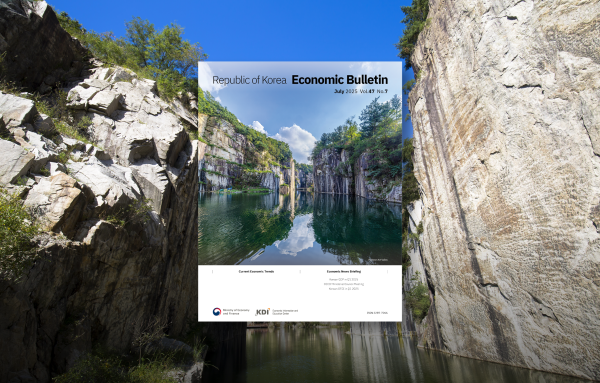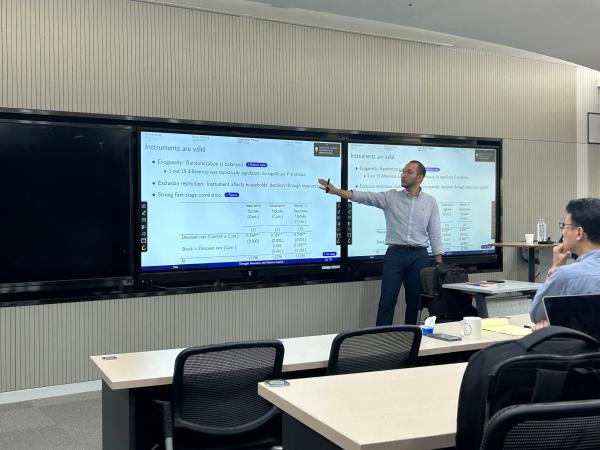
KDI School ✕ World Bank Monthly Webinar: David Mihaly on Understanding the Realities of Hidden Debt
- Date 2025-03-12 10:03
- CategoryResearch and Education
- Hit691
_Poster.png)
The KDI School ✕ World Bank Monthly Webinar was held on February 26. More than 60 participants attended to get valuable insights from David Mihaly, a senior economist at the World Bank, into the complexities of hidden debt. The webinar emphasized the importance of reliable debt statistics for macroeconomic analysis, investment decisions, and government policies. He also highlighted the lack of rigorous academic research on debt transparency.
The study analyzed decades of World Bank debt statistics revisions to quantify the extent, characteristics, and timing of hidden debt. Mihaly identified three key findings: debt statistics are systematically underreported, hidden debt accumulates over time and is revealed during economic downturns, and hidden debt contributes to significant creditor losses during defaults. The study also introduced a sovereign debt and default model, demonstrating that hidden debt increases default risk, raises borrowing costs, and weakens a country’s debt-carrying capacity.
Mihaly illustrated the impact of hidden debt using the case of Mozambique. Undisclosed debt in Mozambique led to the suspension of IMF programs and the withdrawal of donor support. And then, a default on its bonds naturally followed. The hidden debt scandal resulted in rising borrowing costs and prolonged debt negotiations. The minister of finance involved was imprisoned, and legal proceedings were initiated against banks that facilitated the borrowing. An analysis of World Bank data revealed that Mozambique’s borrowing increased significantly in 2013-2014, yet it was not initially reported.
The study defined hidden debt as the difference between initially published debt figures and the latest available data. Researchers digitized World Bank debt statistics from 1973, covering 140 emerging and developing countries. The focus on nominally reported international statistics ensured consistency without valuation distortions. The empirical analysis showed that debt statistics are frequently revised upward, with an average upward revision of 1% of GDP, equating to approximately $160 million per revision. Countries with weaker institutions was more likely to show this pattern.
The research found that hidden debt accumulates during economic booms and is revealed during downturns. Debt disclosures are more common during defaults and International Monetary Fund (IMF) programs, with an average of $200 million in unreported debt uncovered under IMF scrutiny. Hidden debt was linked to extended restructuring processes, resulting in greater losses for creditors and longer default resolution periods. In Zambia, undisclosed debts contributed to delays in restructuring. Including Zambia, countries with significant hidden debt experienced average debt haircuts that increased by five percentage points.
Mihaly's theoretical model, which builds on the work of Eaton and Gersovitz, Agar, and Gopinath and Arellano, incorporates the concept of hidden debt accumulation and its effects on bondholder recovery rates. Lenders, cognizant of the possibility of undisclosed borrowing, must determine whether to conduct audits that could uncover previously unreported debt.

During the Q&A session, there were insightful questions by KDIS students. Elena Elizabeth Dimas Jimenez inquired, “how can my country make sure it is transparent and not hiding from the public?" Mihaly suggested that Bitcoin’s public ledger could enhance transparency; however, its anonymity might obscure debt ownership, complicating impact assessments. Andrea Joyce Cosico Arbues asked, “it could be intentional in a way or it could be also unintentional that these are hidden, but do we know where these debts are like in what aspect of spending?” He emphasized the role of debt management offices but noted that finance ministers can sign loan contracts without notifying their staff, and state-owned enterprises sometimes circumvent the Ministry of Finance.
Sofía Olimpia Narváez Guevara inquired about how financial markets respond when hidden debt is disclosed in Latin America. Mihaly noted that financial market reactions are more heavily influenced by media reports than by the official release of revised debt data. Ying Liu asked, “Do the findings regarding central government debt also apply to local governments?” Mihaly confirmed that similar patterns exist, particularly in decentralized borrowing systems. He said that subnational authorities borrow domestically and display comparable cyclical borrowing and bailout tendencies.
The webinar concluded with discussions on the mechanisms that governments use to conceal debt and ways to enhance transparency. Mihaly suggested leveraging technology, such as large language models (LLMs), for debt contract analysis. He also recommended using reconciliation platforms to verify borrower and creditor data. He underscored the critical role of accurate debt reporting in maintaining economic stability and informing policy decisions at both national and international levels.
2025 Spring / MDS / ROK
thdgus1029@naver.com
Related News
-

Research and Education1 day ago
Republic of Korea Economic Bulletin, July 2025#KDI #Economic #KDISCHOOL #kdischool #Economic Bulletin #Research
-

Story4 days ago
Summer 2025 Talent Donation Program: KDIS Forums Host Sejong High School Students#KDISCHOOL #KDIS #student #talent donation #student forums #student clubs
-

Research and Education5 days ago
Research Seminar by Hyuk Harry Son from Utrecht University


